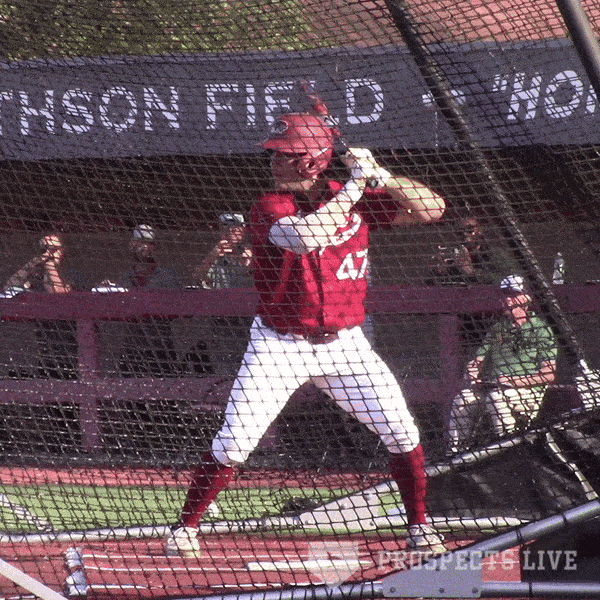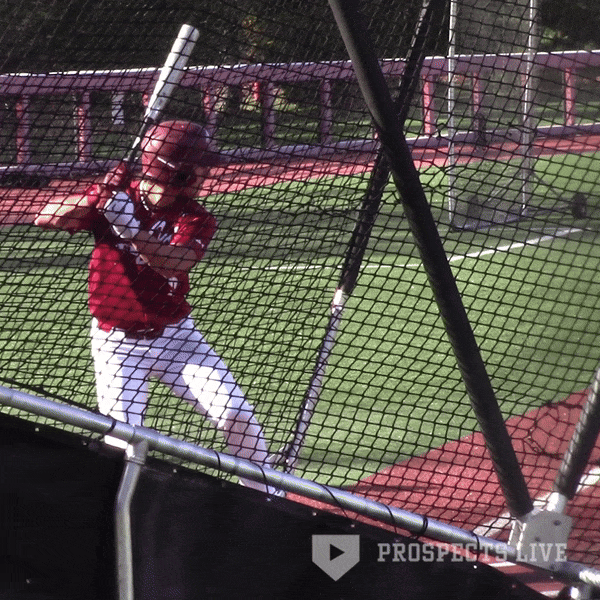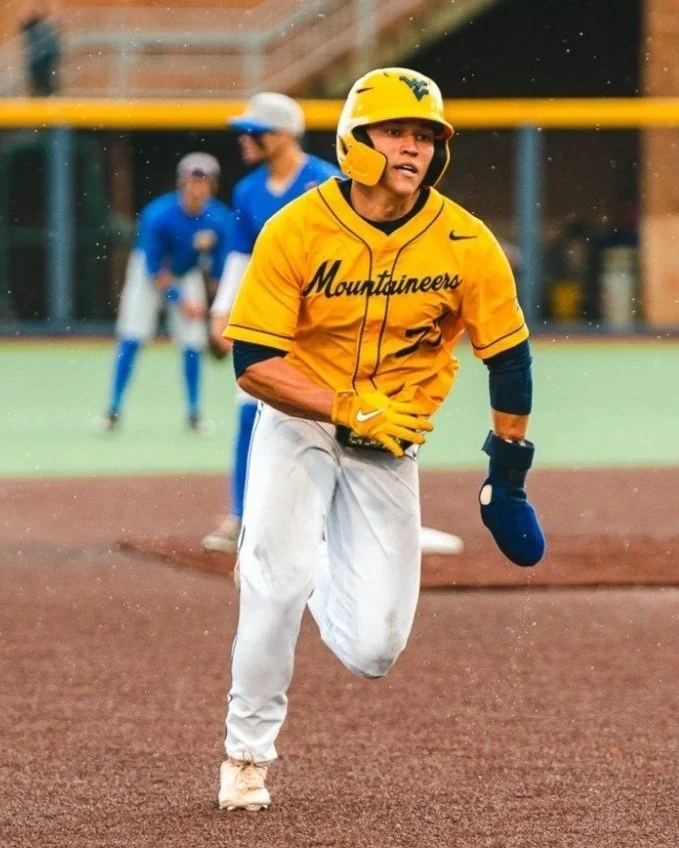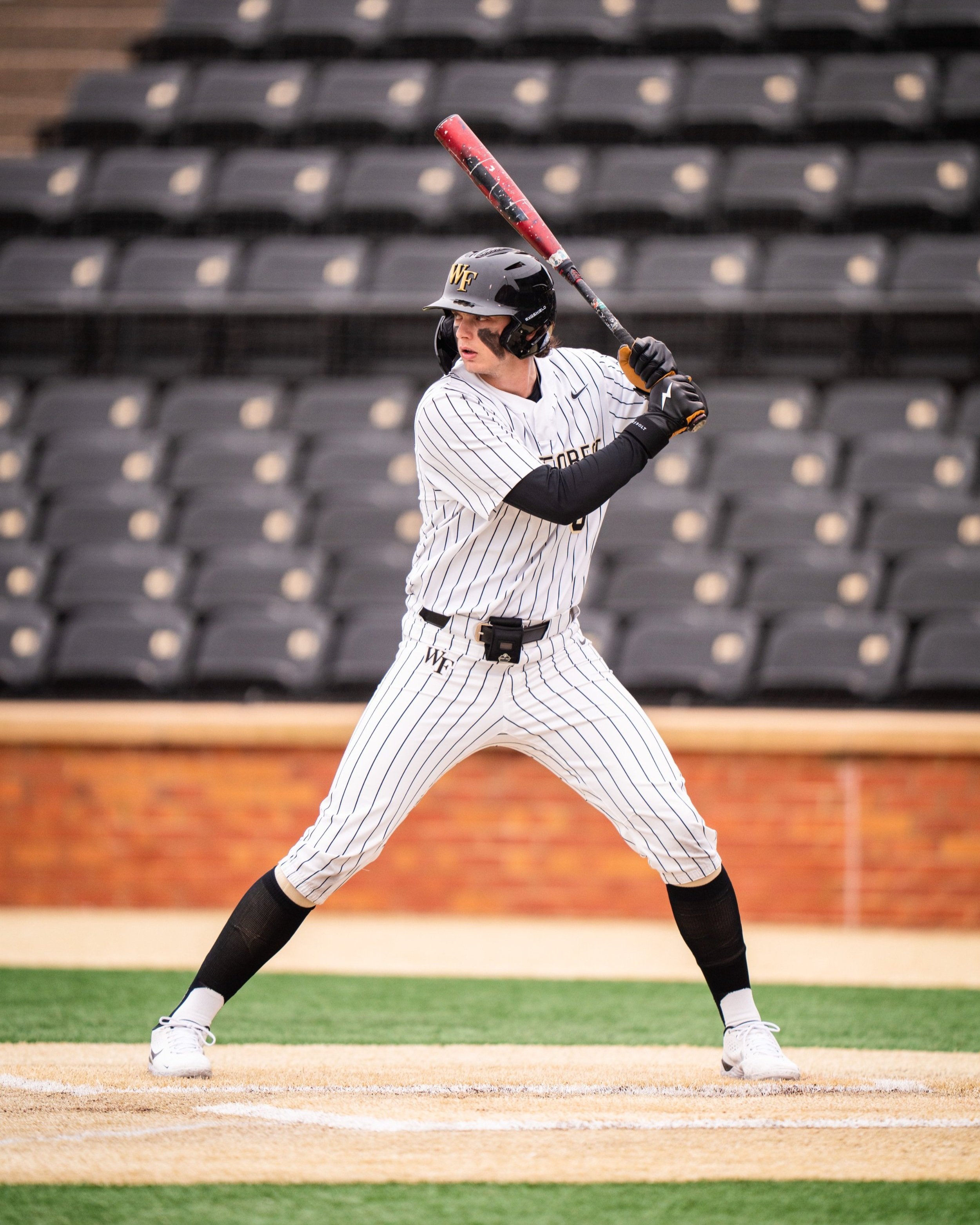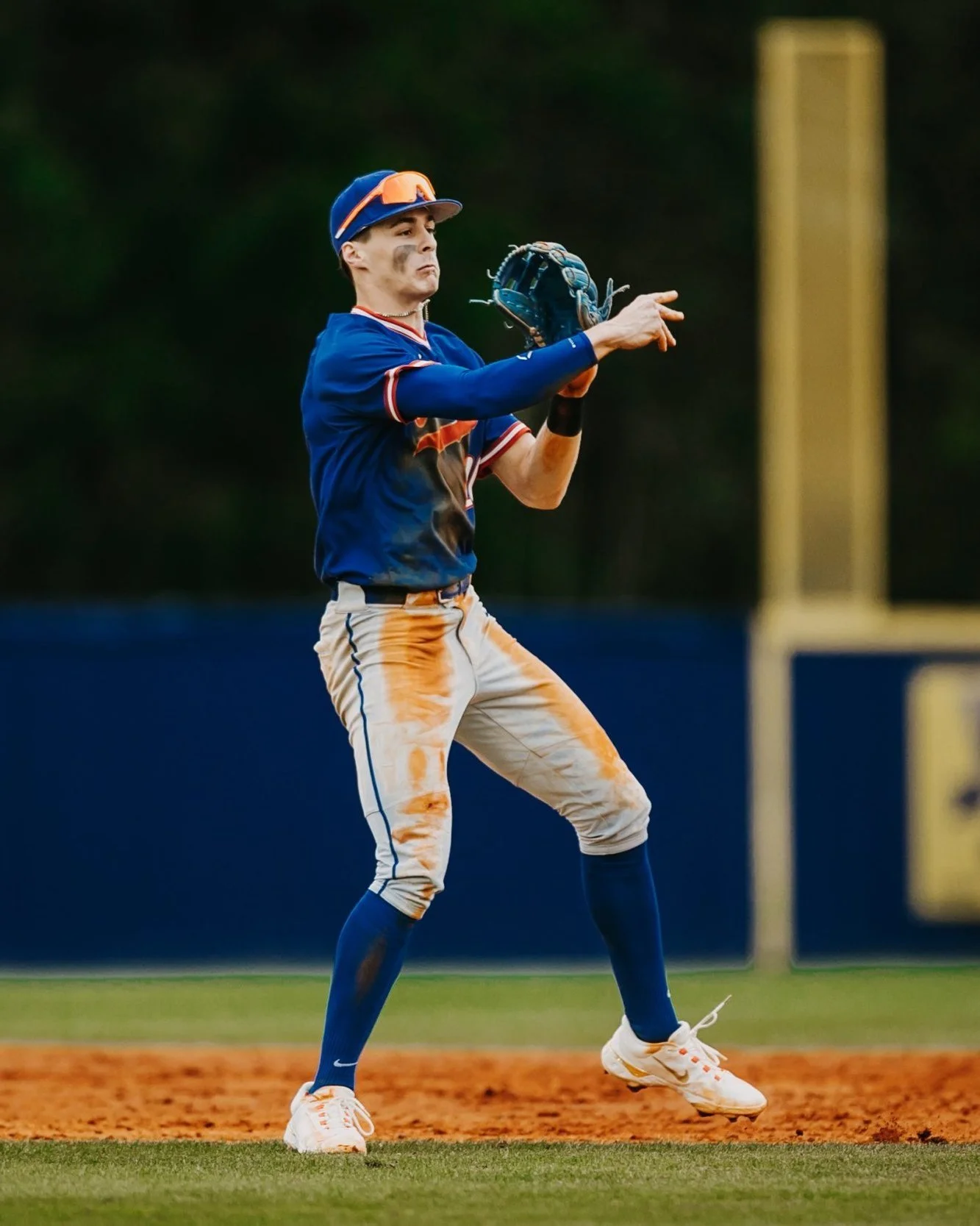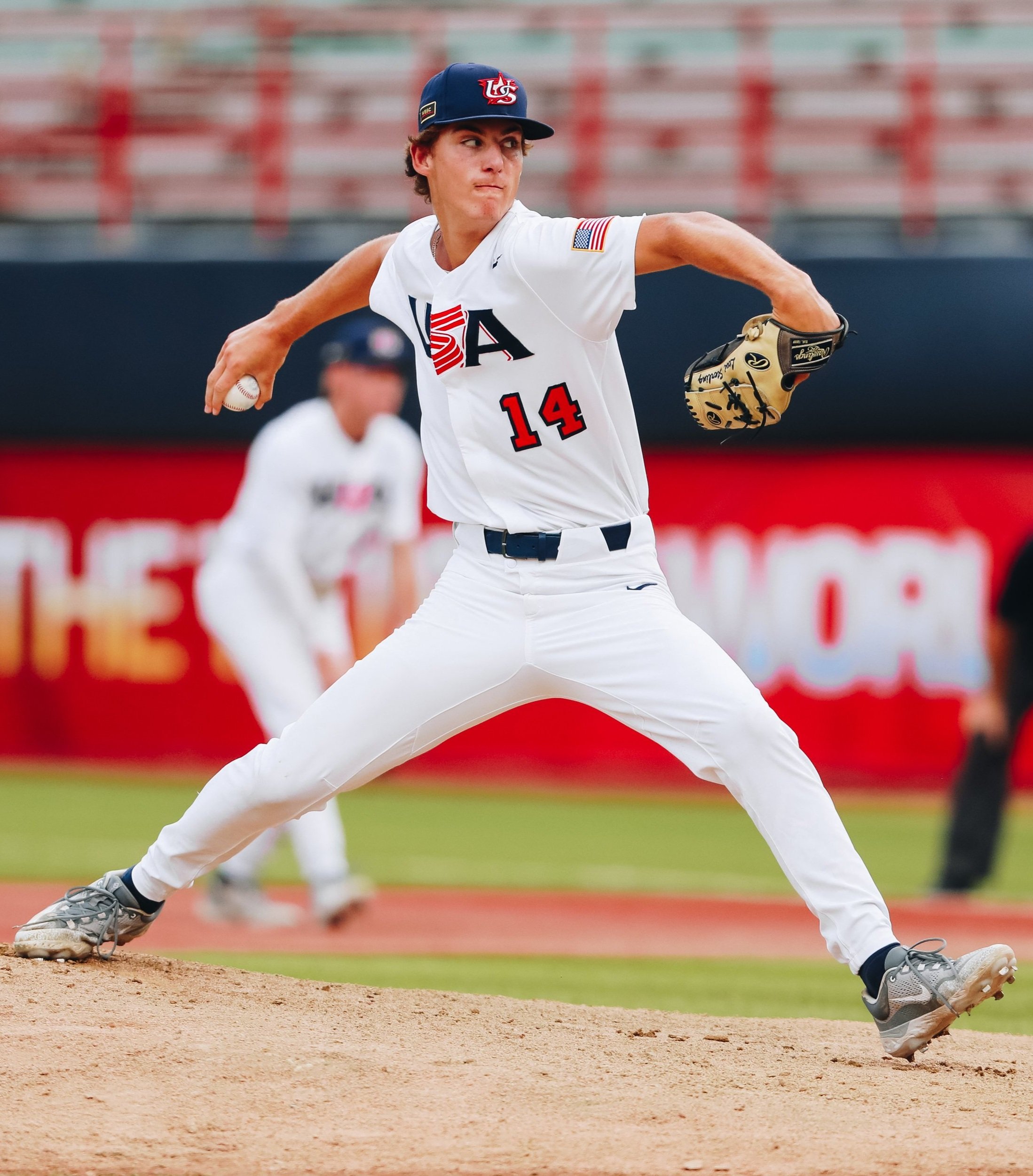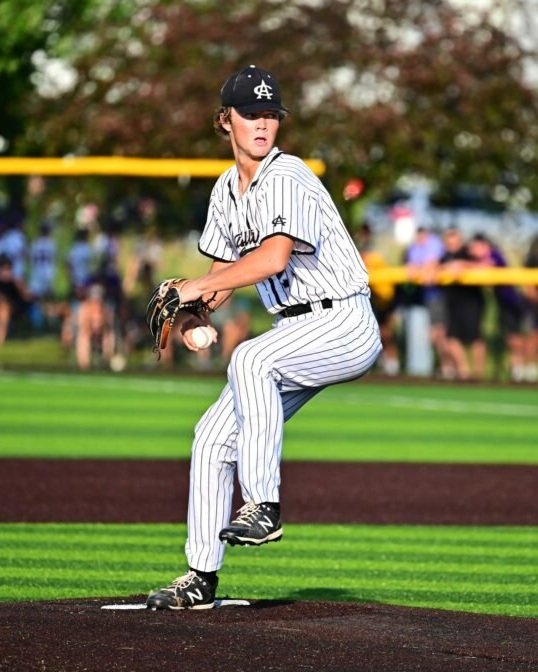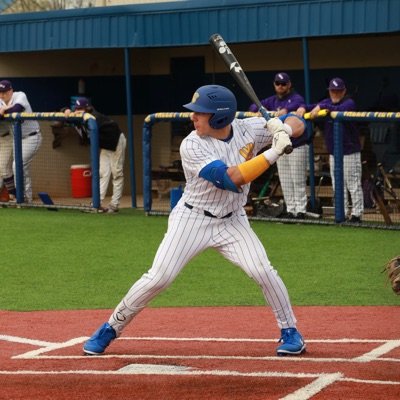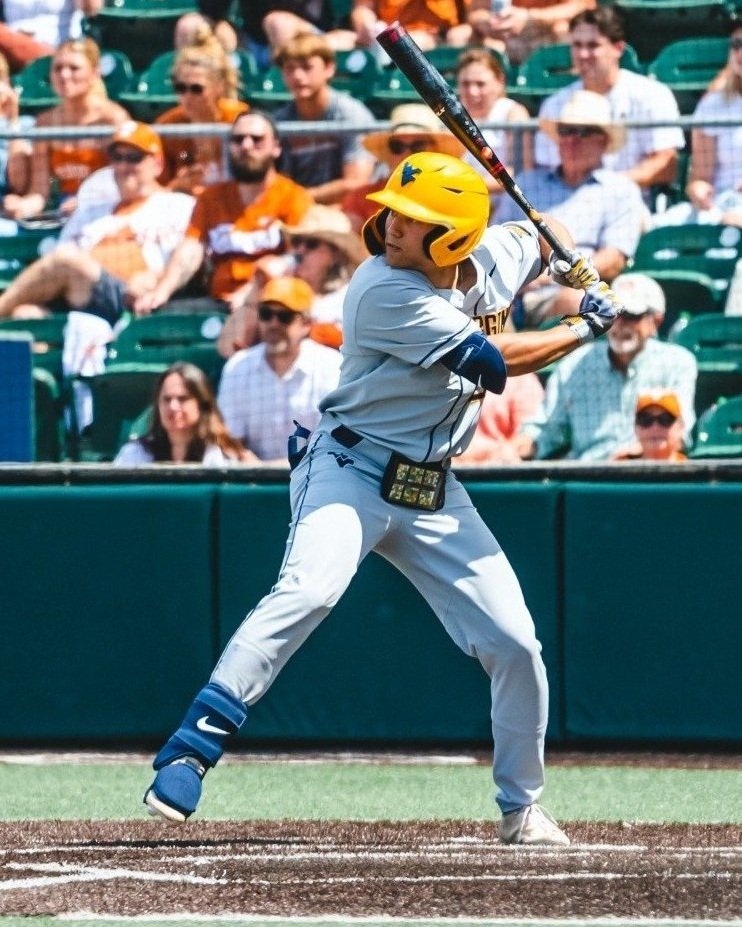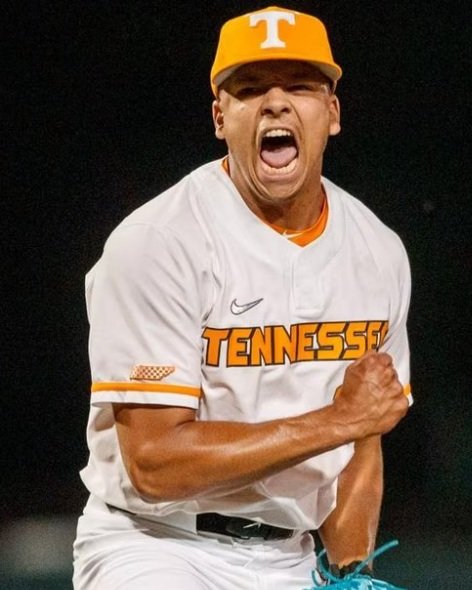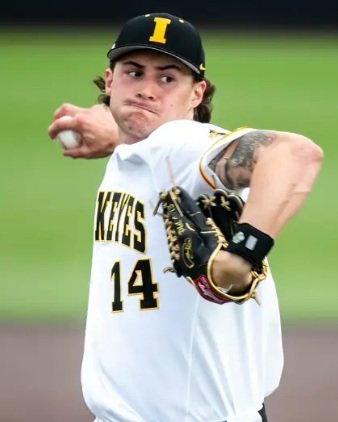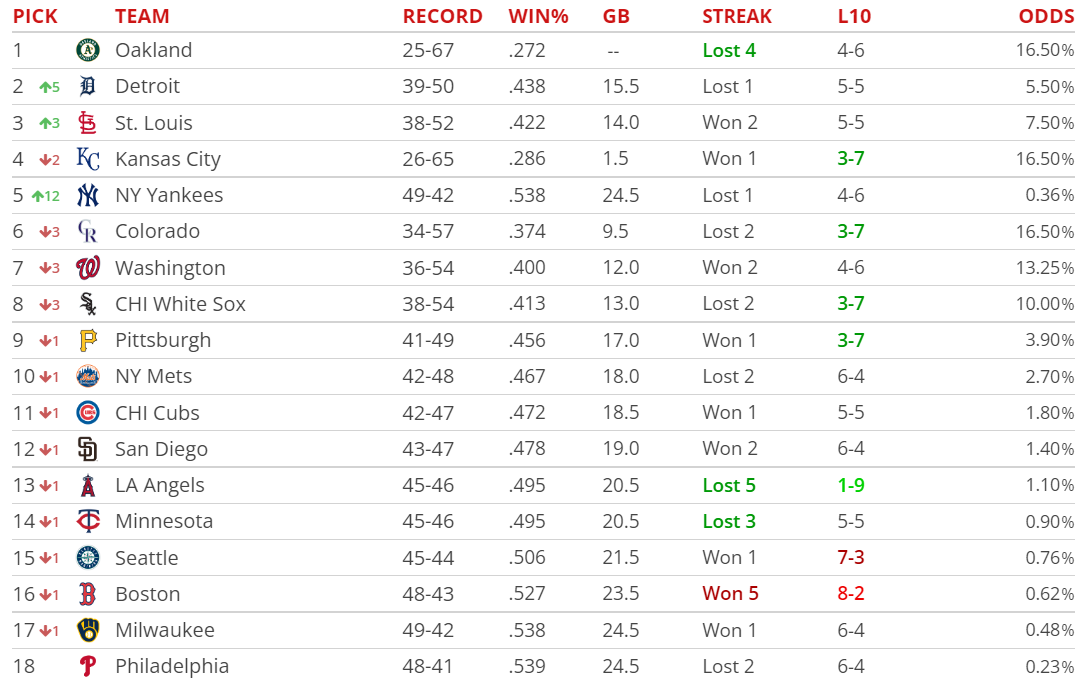To kick off the season, I attended the Shriners College Showdown. For the first time in the event’s history, it took place at Globe Life Field. A great venue for February baseball, fans of Tennessee, Oklahoma, Oregon, Baylor, Texas Tech, and Nebraska flocked to Arlington to watch some indoor baseball to kick off the season. Below are some players that stood out to me, along with a future value grade if they’re draft-eligible this season. I also included some notes on teams that I think can contend for a spot in the College World Series.
Tennessee volunteers
AJ Russell, RHP (2025)
At 6’6”, 195 lbs, Russell is a physical presence on the bump. To go along with this, Russell possesses some of the best stuff in the country. Coming from a ¾ arm slot and a crossbody delivery, it’s a tough AB, especially for right-handed hitters. To begin his start against Texas Tech, and just his second start of his collegiate career, Russell was 97-98 MPH with some crazy run and sink. After his first inning, he fell down to 94-96 MPH, and the velocity continued to fall after that, getting all the way down to 91 MPH. Through the velocity drop, Russell still punched out ten hitters, and eight of the first nine he faced. Russell’s go-to secondary was a 79-82 MPH sweeping slider. He threw this to both right-handed hitters and left-handed hitters and got whiffs from both. He turned over two changeups, one at 87 MPH and one at 83 MPH. They both had nice fade and minimal depth, and it’s a pitch I’d like to see him throw more in the future. He even flipped in a 75 MPH 10-4 curveball, however he did slow his arm a ton on this, something hitters will pick up on.
This was a nice start to build off for Russell. He may have only gone four and a third, but he was likely on a pitch count anyway. He showed he can dominate a lineup even with his diminished fastball velocity. Holding that velocity will be a huge step for him. His breaking ball will play in the SEC, though in the future I’d like to see what it looks like if he threw it a bit harder, maybe around 81-83. It may flatten out the shape a bit and worsen the results against left-handed hitters, but it’d make it an easy plus pitch, and he was borderline unhittable against right-handed hitters. This would also force him to lean on his changeup more as well, a pitch that potential to be a plus offering. Russell still has another year before he’s draft-eligible, but I’d put a first-round grade on him now. There’s a bit of Tanner Houck in here, who went 24th overall back in 2017. While there may be reliever risk, there’s plenty to like as far as starter traits, and Russell will continue to get stronger and better over the next year.
Drew Beam, RHP, 2024, 45 FV
The workhorse of this Vols rotation, Beam is another physical beast on the mound. Coming in at 6’4 and from a high ¾ arm slot, Beam creates a tough vertical angle on hitters. Beam commands his steep 92-95 MPH heater well to both sides of the plate and held his velocity throughout the start. At 79-81 MPH, his above average curveball generated swings in and below the zone. It’s 11-5 shape allowed it to play to both right-handed and left handed hitters. It appeared he mixed in some that had more slider sweeping shape, but he did this to both handiness and at the same velocity, so it was unclear if it was intentional. Third time through the lineup, Beam mixed in more changeups. Thrown in the mid-80s with good fade, it had the shape of an average offering, flashing above. He didn’t have great feel for it however, leaving up in the zone and getting hit around a few times. He even threw some to right handers, and these had a little more depth and even generated a whiff. He mixed in a cutter at 90 MPH, but it got barreled and didn’t have great shape.
Beam didn’t miss a ton of bats in this start, but Oklahoma has traditionally been a team that does a good job of putting the ball in play. For me Beam profiles as a contact oriented high floor back-end starter, with feel for two above average offerings. I do think there’s more risk here than other guys who project as back-end starters. There’s some fastball shape concerns, similar to what Ty Madden faced in 2021. I don’t love Beam’s arm action, as there’s some twist as he pulls the pull out of his glove, which may create some stress on his elbow, thus adding injury risk. Regardless, Beam has a starter frame and commands 92-95 MPH well, as well as two other average or better offerings. I like him to go in the comp round.
Christian Moore, SS, 40 FV
Moore is another physical specimen (a common trend among the Vols) with easy plus bat speed created by an explosive rotational swing. This swing allows him to hammer just about anything on the middle or inner third of the plate. This swing had some downside however, as he was susceptible on the outer third, specifically with spin. There are plenty of big-league hitters who struggle with this as well, and Moore did protect the plate with two strikes a few times against these, but it leaves much less margin for error on the middle to inner third of the plate. Moore is a pull side specialist, consistently looking to catch balls out in front and Moore has a fairly steep swing, which while it allows him to pull fly balls, a trait that often leads to players overperforming their raw power. He showed the ability to work counts and draw walks. Defensively, Moore has above average hands and actions to go along with an average arm. It’s not crazy range, which may move him off short as he continues to fill out.
Moore’s combination of bat speed and power, as well as the chance of him playing shortstop give him the makings of a day one pick. If Moore can show more range this season and that he can stick at SS in pro ball, Moore could be a first rounder. As of now, I have a third round grade on him.
Billy Amick, 3B, 45 FV
A transfer from Clemson, Amick is already proving to be one of the best portal adds in the country. Amick is a monster in the box, showing power to all fields and good feel for the barrel. He produced some consistently crazy exit velocities over the weekend, with his best bolt being an 112 MPH moonshot that landed in the second deck, an spot you don’t see many college players reach at Globe Life Field. It’s easy double plus raw power. Amick can cover fastballs on both sides of the plate. There’s even a little bit of a scissor in his lower half at times, something you see from hitters who rotate aggressively. However, he did put up some bad ABs against spin, usually due to his aggressiveness. Oklahoma exploited this, spinning him more than any team over the weekend, a game where he struck out three times. Amick has had chase and swing and miss problems in the past, and Oklahoma exploited his aggressiveness. There’s still real hit tool concerns here as he’s been prone to chase a ton to go along with below average contact rates. While mostly playing 1B at Clemson, it looks like Amick will man down the hot corner for the Vols in 2024. There were some question marks about his ability coming into the season, but he’s off to a nice start thus far, making a real nice play on his backhand and throwing on the run to catch a speedy runner. Amick has the makings of a third basemen, with above average arm strength and average hands.
With a great season this year, proving himself as a third basemen and improving his patience or contact ability at the plate, Amick could see his stock skyrocket in 2024. For now, I’ve got Amick as a day one pick, around the second to third round with a good chance to shoot into the comp round.
Dylan Dreiling, LF, 2024, 40 FV
At 5’11”, Dreiling’s power outplays his size by a good bit. Dreiling features an explosive swing, where he cuts across the zone and often will end up shifting his feet on impact. It’s plus bat speed, and likely plus raw power as well. Clobbering a 112 mph, 430-foot blast over the bullpen in left center field, Dreiling already beat his max exit velocity from 2023. Because of how Dreiling’s swing cuts across the zone, he has had some trouble covering the outer third of the zone. This has led to some big-time struggles’ vs left-handed pitching, something that kept him out of the lineup at times in 2023. He does feature a nice approach however, as a very patient hitter who walked more than he struck out in 2023. A below average runner, Dreiling isn’t great in the outfield, but does feature average arm strength. He looks like a pretty run of the mill left fielder.
If Dreiling is able to shore up his troubles vs lefties and on the outer third of the plate, you’re looking at a hitter who could sneak into the back end of the first round, similar to how Chase Davis did in 2023, however Davis had better raw power. For now, Dreiling looks like a second or third rounder, with the role of a platoon power hitting outfielder.
Aaron Combs, RHRP 2024 (senior), 35 FV
Combs was one of my favorite arms of the weekend. A Junior College transfer, Combs features a short arm action to pair with a repeatable rotational delivery, creating a ¾ arm slot. This arm slot allows him to throw some nice two seamers, which he threw off the front hip of left handed hitters, and ran into righties. At 91-94 MPH, Combs even was able to get whiffs at the top of the zone with his heater. Combs’ best pitch however, was his 78-81 MPH 11-5 above average curveball, which he showed great feel for. This pitch generated whiffs out of the zone and as well as in the zone, and was a great weapon for Combs. He flashed a changeup with nice fade at 85 MPH as well, a pitch that he should have good feel for from his arm slot. The Vols had him pitch into a third inning however, where his stuff and command fell off a good bit.
Combs is likely to be a big weapon for this Vols bullpen in 2024, and will likely get some save opportunities. With a good season where he generates strikeouts like he did in 2023, he could be a nice day three senior sign for a team.
AJ Causey, RHRP, 2024, 35 FV
Causey followed Russell on Friday night against Texas Tech, and filled up the zone. A funky sidearm delivery, Causey was 89-92 MPH, topping at 93 MPH with his heavy sinking, top spinning fastball. Causey did a good job limiting hard contact, with the exception of a triple on a slider he left up in the zone. Causey’s slider is 77-78 MPH with plus sweep and minimal depth. Because of it’s velo and lack of two-plane shape, it’s unlikely to miss bats in the zone, but because of his slot and how it pairs with his fastball, it will definitely get plenty of chases. Causey also turned over some nice 77-79 MPH changeups, with plenty of depth while still maintaining arm side run. This pitch gave left handed hitters fits, getting whiffs in the zone and chases.
Causey threw five innings for the Vols on Friday, and maintained his velocity and stuff well. He’ll be a nice weapon for the Vols out of the pen as a long man, and could be the answer for as their Sunday starter. Since he went five innings, I’m curious what Causey’s velocity would be in a one inning stint, which is likely the role he’d be given in pro ball. Causey will be a solid day three bullpen pick for a team, and if he adds velocity to his secondaries, he could move quickly through the minors and see himself in a big league bullpen soon.
Blake Burke, 1B, 2024
Perhaps the most notable name in this Vols lineup, Burke possesses easy 70 grade raw power. A swing where he completely throws his hands at the ball, it’s easy plus bat speed. Burke had a rough weekend, where teams pounded him inside and up most the weekend, getting jammed quite a bit. He fouled off some fastballs that he’d normally punish, but I expect him to be fine as the season progresses. Burke has avoided strikeouts more than you’d expect for someone with his type of profile, thanks to a two strike approach where he shortens his stance up and throws his hands at pitches, repeatedly fouling them off. When he’s able to extend his arms, it usually results in hard contact. I didn’t get a great look at Burke, so I don’t feel comfortable putting a grade on him just yet, but players like him have typically gone in the third to fifth round of the draft
Young Volunteer Flamethrowers
Two different right handers came out of the pen lighting up the radar guns for the Vols this weekend, Marcus Phillips and Nate Snead. The freshman Phillips is a physical specimen at 6’4 245, and started at 97-98 MPH, trickling down to 93 MPH with a poorly shaped fastball. Control over command and not much feel for his upper-80s slider, this should be an effective weapon against college hitters, and control will improve over time. The sophomore, Snead, a Witcha St transfer, came out with an easy 98-100 MPH two seamer, that dripped down to 94 MPH. A hard slutter at 85-87 MPH, Snead struggled with control over his five innings, walking five, but his stuff was so good that it really didn’t matter. Both should be nice weapons out of the pen for the Vols, in 2024 and beyond.
Final Notes
This Vols team looks primed to do some damage in 2024. While they may be missing a true table setting, on base guy at the top, it’s still a deep lineup 1-9, and every player has the capability to put the ball in the seats. The only real weakness I see is they may have some trouble against pitchers with good breaking balls, but there aren’t many college lineups that don’t. The two headed monster of Russell and Beam is sure to give opposing hitters fits, and there’s a lot of velocity and stuff to overpower college hitters in the pen. One common theme I noticed here was a lot of pitchers had similar breaking ball shapes. Russell, Causey, Snead, even Beam. It was this sweepy slider, usually around 79-81 MPH. The stadium radar typically identified them as curveballs, likely because they’re around -5 IVB with 10+ inches of sweep, but I’d imagine the Vols call them sliders. Part of this, if I had to guess, is that this shape plays vs both lefties and righties more than a traditional sweeper would and allows a pitcher to just have to focus on one secondary pitch. This is purely speculation, and just something I noticed.
Texas Tech Red Raiders
Kyle Robinson, RHP, 2024, 40 FV
Robinson had a tough task to make his sixth career start against a loaded Tennessee lineup but managed to limit damage. At 6’6” and an over-the-top delivery, Robinson’s steep downhill fastball creates a tough angle on hitters. Starting at 93-94 MPH and settling in at 91-93 MPH, Robinson struggled commanding this pitch. There were many times throughout the outing if he could have placed it glove side or at the letters he could have gotten out of trouble. Robinson’s best pitch is his 84-86 MPH tumbling changeup. Thrown with the same arm speed as his fastball, it’s a deceptive pitch that really falls off the table. Its depth allows it to play to both right handers and left handers, and he used it that way, and got whiffs from both. He also leaned on a 76-77 MPH 12-6 curveball, using it when behind in counts and to generate whiffs. Robinson mixed in some 87-90 MPH slutters. This had some nice lift, and average glove side movement. It’s not going to generate swings and misses, but rather is a good weapon to get off the barrel of specifically left-handed hitters, something he did to Blake Burke.
There’s a lot to project on here for Robinson. Sold velo, not much experience starting, a plus changeup, an average curveball he has feel for. While there are some questions regarding how his fastball will play, and not having a true weapon to get right-handed hitters out, there’s still mid rotation upside here. I’ve got a sixth round grade on Robinson, with some nice potential to shoot up the board with improved fastball command and a solid season.
Kevin Bazzell, C/3B, 2024, 45 FV
A stocky right-handed hitter who played third base most of last season, Bazzell looks like he’ll be the Red Raiders’ primary catcher in 2024 with the addition of third basemen Cade McGee and the departure of Hudson White. At the plate, Bazzell is very steady. A level swing, Bazzell makes contact at a high clip, and can cover most parts of the plate. Bazzell doesn’t chase much, though his passiveness got him in a bit of trouble over the weekend, as he got caught watching strike three on the outer third a few times. While they weren’t all strikes (though they were called strikes), you’d like to see him protect the plate on a 50/50 call with two strikes. Bazzell has average bat speed and raw power, but his level swing probably won’t allow him to fully tap into his raw power, so it’s likely below average power. Defensively, Bazzell was fairly raw behind the plate, as this is his first time playing catcher full time since high school. Bazzell was a solid receiver on the corners of the plate, stealing some strikes, but didn’t get many calls at the bottom of the zone. Bazzell hasn’t had many times to show off his arm behind the plate, but when he did they were around 1.95 second pop times with average arm strength. It’ll be interesting to see how this progresses as the season goes on, and how Bazzell can limit the run game in the Big 12.
At the plate another nice season will keep Bazzell’s draft floor pretty high. Bazzell is a sound hitter and looks like he might be average or even better. While catchers can be incredibly tough to evaluate and project, Bazzell is going to keep getting better, and already has the looks of an average catcher. At the plate, Bazzell reminds me a lot of Max Anderson, who went in the second round. Bazzell is a better defender and plays a more premium position than Anderson. I’m going to assume Bazzell is going to keep getting better at catcher and keep raking, and I see him as a first rounder.
Zane Petty, RHP, 2025
Petty got the ball on Saturday for the Red Raiders after a strong end to his 2023 campaign. Petty has good stuff, but struggled with control for a large part of his outing. Petty has a very high leg lift, something he often struggled to repeat. Combine this with his high effort delivery and head whack, and inconstant arm path, and his delivery was often out of sync. Petty started out 94-95 MPH with good shape from his high three quarters arm slot, before sitting 90-93 MPH. Petty has two distinct breaking ball shapes, a two-plane slider and an 11-5 curveball. The slider’s two plane shape and average sweep at 82-83 MPH. Petty was able to land these for strikes, but they were up in the zone so they were hit around a bit. At 78-80 MPH, Petty struggled to land this pitch, with it popping out of his hand a few times allowing hitters to lay off.
Despite the loud stuff, Petty hasn’t missed bats at a high clip in his career, likely due to the his struggles with command and control. If Petty can find another level of control this season and next, he has the potential of a day one pick, but finding this will be a critical part of his development, or else he’s just a high stuff reliver that doesn’t miss bats and struggles to find the zone.
Cade McGee. 3B, 2024, 35 FV
McGee was off to a hot start at Gonzaga in 2023 before sustaining an injury that sidelined him for a large bit of the season. In his limited time, he’s shown a great feel for the zone and high contact rates. That was on display this weekend, drawing four walks and working counts in his favor. McGee has below average bat speed and raw power, something you wouldn’t expect to see from a third basemen typically. Defensively however, McGee is sharp. With good athleticism for his size, McGee made a nice play coming in and a good throw on the run. Solid hands, good footwork, and an above average arm, McGee looks like he’ll stick at third moving forward. With a good season in the Big 12, McGee has the makings of an early day two pick and is a player to keep an eye on this season.
TJ Pompey, SS, 2026
A well-rounded freshman, Pompey had a nice weekend to kick off his collegiate career. In his second at bat of his career, Pompey shot a 101 MPH fly ball into the right center gap for a triple to put the Red Raiders back in the game. This was one of four hits Pompey had on the weekend at the bottom of the Tech lineup. Pompey has a fairly steep bat angle, which allowed him to fair well against secondaries, putting some good swings on sliders and changeups, but got some fastballs blown by him. Pompey has nice actions at short, but below average hands, to go along with average arm strength, but good arm utility, making a nice throw off his right foot on the run to nab a speedy runner. He did make an error on a backhand, but he got a nice first step and it would have been a tough play anyways. Pompey is a name to watch this season as he gets his feet wet at shortstop and college baseball.
Gavin Kash, 1B, 35 FV
Kash had a rough weekend at the plate, striking out seven times in fourteen plate appearances. Kash had a tough time picking up offspeed and struggled to see the ball against lefties it seemed. I’ve seen Kash a few times in the past few years (and watched an impressive BP while he was a freshman at Texas), and he had an arm bar in his swing that I didn’t remember him having in the past. Kash has nice bat speed that pairs with a steep swing geared for power, though this makes him prone to swing and miss at breaking balls and fastballs up in the zone. In the past, he showed a good approach and the ability to work counts, but that was lacking this weekend. I won’t panic on Kash yet based on the first weekend of the year where he saw plenty of quality arms and left handed pitchers, as I still like the power and patience he’s shown in the past. Similar to Burke, I don’t feel comfortable to put a grade on Kash after his struggles this weekend, but this profile generally goes in the third to fifth round of the draft.
Final Notes
This Tech team may not have the star power of the Jung brother teams of years past, but it’s deeper than most teams I can remember. I didn’t even mention Damian Bravo or Austin Green, who will both likely slug over .500 and be big parts of the team. This lineup is capable of doing a lot of different things (and will always hit homers in the launch pad that is Dan Law Field), and if Graham Harrellson can get going, it’s an incredibly well-rounded lineup. While they may lack top end talent, it’s a deeper pitching staff than most years. Robinson, Petty, and a pitchability righty in Washburn is a solid rotation, and the bullpen is experienced and deeper. Parker Huytra is 93-94 MPH with a nice slider, Josh Sanders is 90-92 MPH with heavy sink, it seemed like every arm they were throwing out was 90-92 MPH and landing a solid slider. Depth is critical for winning in the postseason, and Tech looks like they have it this year.
Oklahoma SOONERS
Brendan Girton, RHP, 2024 Senior, 35+ FV
I liked Girton when he was at Texas Tech last year as big bodied, stocky righty with good pitch shapes but command issues. He’s since transferred to OU for his senior season, and it looks like he’s going to get a chance to start. In his first start against Tennessee, he had a strong showing. While he struggled with his command to start, he settled in with his fastball slider combination. Starting at 94-95 MPH and settling in at 92-94 MPH, Girton’s fastball has great carry to go with some deception and a relatively low release height. Getting sixteen (!) whiffs, the Vols were consistently swinging under this deceptive fastball. Girton’s go to secondary is a mid-80s sweeping slider. This pitch is sharp, and even flashed plus sweep, and has great separation from his fastball. Girton doesn’t have great feel for this pitch, but it improved as his start progressed. This combination was good enough on their own, so Girton only threw one changeup at 84 MPH, and it may be tough for him to consistently get to the side of the ball given his high three-quarter release point. Girton didn’t strike many people out during his time in Lubbock, so for him to begin the season with an outing like this is a great sign.
Professionally, Girton profiles as a reliever. His delivery is a bit inconsistent and has some tweaks to be made, for example he doesn’t stack his torso well, leading to him to be somewhat slouched over, making it tough to rotate at times. Should Girton show he can consistently throw enough strikes with his fastball slider combination over the course of a season, he has the looks of a day three senior signing, with a chance to move quickly.
James Hitt, LHP, 2024 (Senior), 35 FV
A young senior, Hitt is another Texas Tech transfer. In 2023, he appeared in seventeen games, starting twelve, but struggled to miss bats. In his first outing of the year against Nebraska, Hitt struck out ten on 88 pitches. Hitt’s fastball is likely his worst pitch. While it is 91-93 MPH and up to 94 MPH from the left side, the shape is incredibly inconsistent, and it’s control over command, leaving many over the middle of the plate to get barreled. Hitt heavily relied on his 78-81 MPH curveball that flashed plus. Hitt was able to bury this to right-handed hitters and got plenty of chases in the dirt from lefties. He also throws a 80-81 MPH slider that has mostly bullet spin, but his three-quarters slot creates some deception, thus adding some sweep. Later in the outing, he started throwing a filthy 84-85 MPH changeup. This pitch flashed plus as well, falling off the table and showing some nice fade as well. These secondaries carried Hitt through his start and made up for his hittable fastball.
A great start to the season, Hitt should continue to throw his secondaries more and more, and only rely on his fastball when he needs to. Should he continue to show he can miss bats with his curveball changeup combination, he has a nice floor as middle reliever and could see himself taken on day 2 of the draft around the 10th round.
Malachi Witherspoon, RHP
Malachi Witherspoon was the first arm out of the pen for the Sooners on Friday. A JUCO Transfer, Witherspoon has a nice body at 6’3” and 190 pounds, he still has room to fill out. This is a little scary, considering Witherspoon was 94-97 MPH, and up to 98 MPH with his fastball. Witherspoon gets to the side of this, and it’s a relatively over the top arm slot so it’s not great shape, but the velocity plays. Malachi’s go-to secondary is a top down, 78-80 MPH high-spin curveball. He showed nice feel for this pitch, landing it for strikes, but struggled to bury it below the zone when needed. Not concerned here though, as this is usually something that comes with time. There’s some herk and jerk in Witherspoon’s delivery, and he lost feel at a few points, but he’s young and will get better with time. Witherspoon looks like he’ll be an electric arm out of the Sooner pen for years to come.
Kyson Witherspoon, RHP
The brother of Malachi, Kyson is another electric arm for the Sooners. He’s a little more filled out than his brother and has more refined, repeatable delivery. A short, over the top arm action, Kyson was 95-96 MPH to start before settling in at 93-94 MPH. With nice carry and cut, Witherspoon had nice touch on this pitch, throwing it for strikes. His best weapon however was a 83-85 MPH slider with two plane break that he commanded very well. It’s hard to find this level of feel for this nice of a breaking ball in a 19-year-old, and Witherspoon has it. Witherspoon didn’t need to throw any changeups, and it may be tough to throw from his arm slot, so if he really needed to add a third offering for left-handed hitters, I’d like to see it be a 12-6 curveball. It’s worth keeping an eye on if Kyson pitches his way into the Sooner rotation, as he certainly throws enough strikes to do so.
Final Notes
It looks like another textbook Sooners team in Norman. The lineup is going to make a ton of contact and steal plenty of bags to go along with it. The rotation is solid, with some nice upside, but they have better weapons in the pen than they have in the past with the Witherspoon brothers. OU will certainly contend for the Big 12, and they’re the type of pesky team that can make noise in the postseason.
Oregon ducks
Drew Smith, 3B, 2024, 35 FV
An agile 3B, Smith had a nice weekend at Globe Life. Smith features a level swing with nice ability to manipulate the barrel. He showed the ability to cover the outer third of the plate well against secondaries, shooting them back up the middle and to right field on a line, often hit hard. Smith didn’t showcase any crazy power (max EV of 105), but rather consistent hard contact. Combine this with a smart approach, and not much chase at the plate, and you’ve got the looks of a fringe hitter. Defensively, Smith possesses nice footwork and hands, making a nice sliding play to his left. His arm strength could definitely improve, but if this is the biggest weakness defensively, I’m confident he can get stronger and stick there. Smith is the leadoff hitter for Oregon and will be an important piece for them this season. A solid season and he could sneak into the early rounds of day two of the draft.
RJ Gordon, RHP, 2024 Senior, 30+ FV
Gordon started on Friday for the Ducks against Oklahoma and put together a solid outing on a pitch count, pitching into the fifth and limiting hard contact. Gordon was 90-93 MPH and up to 94 MPH with a fastball that had good carry and cutting shape, a tough AB to left-handed hitters. Coming from a high three-quarters slot and a drop and drive delivery from a strong lower half, Gordon commanded this pitch well and filled up the zone with it. He also featured a 73-77 MPH 11-5 breaking ball, thrown mostly to left-handed hitters. It didn’t miss bats but was a nice strike stealer that put in the zone often. Gordon only threw what I thought his best pitch was seven times, his 81-83 MPH changeup. It had really nice separation off his fastball and above average glove side run. Getting two whiffs in the zone on it, I was impressed that a pitcher like Gordon, who naturally cuts and gets to the ball, was able to turn over a changeup like this. What surprised me most about Gordan was he didn’t throw a big slider, instead he threw an 84-87 MPH slutter. This pitch didn’t do much for me, not having much depth or glove side movement. A pitch to get off the barrel of a left-handed hitter? Sure, but not a weapon against righties, like he was using. Gordon has the arm path and supination bias that a lot of teams correlate to throwing a good breaking ball, specifically a sweeper.
You don’t normally see senior signs as dev projects, but I think teaching Gordon a sweeper would be a relatively easy process. Gordon also missed all of 2023 with an injury, so that’s even more development time he missed on. There’s potential of a fringe fastball with above average command, an above average changeup, fringe curveball that can steal strikes, and a potential plus slider. That’s the making of a back-end starter, and if a team can get that at a senior sign bargain, that brings a ton of value to an organization.
























